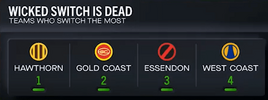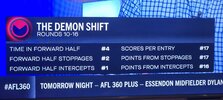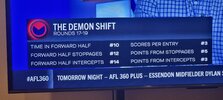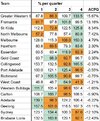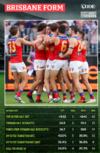So considering Grasshopper17 has been doing so much homework I felt I better contribute again and update my stats differential across the season.

The green highlights a positive differential in that category and the red highlights a negative. This supports my "eye check" that we have been getting a lot more possession, and are no longer massively conceding the disposal count each week. I think this has a lot to do with our controlling of the ball and switching of the play style that IMO was nonexistent in the first half of the year. It looks like we have really swapped that around and now we have been still comfortably winning the kicks AND overall disposal count. A good trend towards the end of the season
What I also thought could be interesting would be to see how well we were also restricting teams in their disposal.

What this is showing is is the number of disposals that our opposition got in their game with us verses their average for the year. So for example Geelong had 203 kicks against, their average is 209.7, so their differential for this game was -6.7. Essentially in this case if you see a red square, that means they were down on their average for their game against us.
I think this shows a clear trend line since the essendon game where we are massively restricting teams in the number of disposals they usually have, while we continue to have more and more of the ball. Its an impressive form line we have started to hit, and its great to see we have continued it across both the Melbourne and Geelong games.
TLDR: We are winning overall disposals while also restricting opposition to below their normal averages in disposals.
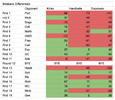
The green highlights a positive differential in that category and the red highlights a negative. This supports my "eye check" that we have been getting a lot more possession, and are no longer massively conceding the disposal count each week. I think this has a lot to do with our controlling of the ball and switching of the play style that IMO was nonexistent in the first half of the year. It looks like we have really swapped that around and now we have been still comfortably winning the kicks AND overall disposal count. A good trend towards the end of the season
What I also thought could be interesting would be to see how well we were also restricting teams in their disposal.
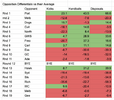
What this is showing is is the number of disposals that our opposition got in their game with us verses their average for the year. So for example Geelong had 203 kicks against, their average is 209.7, so their differential for this game was -6.7. Essentially in this case if you see a red square, that means they were down on their average for their game against us.
I think this shows a clear trend line since the essendon game where we are massively restricting teams in the number of disposals they usually have, while we continue to have more and more of the ball. Its an impressive form line we have started to hit, and its great to see we have continued it across both the Melbourne and Geelong games.
TLDR: We are winning overall disposals while also restricting opposition to below their normal averages in disposals.




